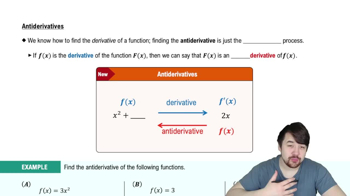Matching functions with area functions Match the functions ƒ, whose graphs are given in a― d, with the area functions A (𝓍) = ∫₀ˣ ƒ(t) dt, whose graphs are given in A–D.
Table of contents
- 0. Functions7h 54m
- Introduction to Functions16m
- Piecewise Functions10m
- Properties of Functions9m
- Common Functions1h 8m
- Transformations5m
- Combining Functions27m
- Exponent rules32m
- Exponential Functions28m
- Logarithmic Functions24m
- Properties of Logarithms36m
- Exponential & Logarithmic Equations35m
- Introduction to Trigonometric Functions38m
- Graphs of Trigonometric Functions44m
- Trigonometric Identities47m
- Inverse Trigonometric Functions48m
- 1. Limits and Continuity2h 2m
- 2. Intro to Derivatives1h 33m
- 3. Techniques of Differentiation3h 18m
- 4. Applications of Derivatives2h 38m
- 5. Graphical Applications of Derivatives6h 2m
- 6. Derivatives of Inverse, Exponential, & Logarithmic Functions2h 37m
- 7. Antiderivatives & Indefinite Integrals1h 26m
- 8. Definite Integrals4h 44m
- 9. Graphical Applications of Integrals2h 27m
- 10. Physics Applications of Integrals 3h 16m
- 11. Integrals of Inverse, Exponential, & Logarithmic Functions2h 34m
- 12. Techniques of Integration7h 41m
- 13. Intro to Differential Equations2h 55m
- 14. Sequences & Series5h 36m
- 15. Power Series2h 19m
- 16. Parametric Equations & Polar Coordinates7h 58m
8. Definite Integrals
Fundamental Theorem of Calculus
Problem 5.3.10
Textbook Question
Explain why ∫ₐᵇ ƒ ′(𝓍) d𝓍 = ƒ(b) ― ƒ(a)
 Verified step by step guidance
Verified step by step guidance1
Step 1: Recall the Fundamental Theorem of Calculus, Part 1, which states that if a function ƒ is continuous on [a, b] and differentiable on (a, b), then the integral of its derivative ƒ′(𝓍) over [a, b] is equal to the net change in ƒ(𝓍) over that interval.
Step 2: Write the mathematical expression for the Fundamental Theorem of Calculus: ∫ₐᵇ ƒ′(𝓍) d𝓍 = ƒ(b) ― ƒ(a). This equation shows that the definite integral of the derivative of ƒ(𝓍) from a to b gives the difference between the values of ƒ(𝓍) at the endpoints b and a.
Step 3: Conceptually, the derivative ƒ′(𝓍) represents the rate of change of the function ƒ(𝓍). Integrating ƒ′(𝓍) over the interval [a, b] accumulates all the infinitesimal changes in ƒ(𝓍) over that interval, resulting in the total change in ƒ(𝓍) from a to b.
Step 4: To understand this geometrically, think of the integral ∫ₐᵇ ƒ′(𝓍) d𝓍 as calculating the area under the curve of ƒ′(𝓍) over [a, b]. This area corresponds to the net change in the original function ƒ(𝓍) over the interval.
Step 5: Finally, note that this relationship holds because differentiation and integration are inverse operations. The integral essentially 'undoes' the differentiation, leaving you with the original function evaluated at the endpoints: ƒ(b) ― ƒ(a).
 Verified video answer for a similar problem:
Verified video answer for a similar problem:This video solution was recommended by our tutors as helpful for the problem above
Video duration:
1mPlay a video:
Was this helpful?
Key Concepts
Here are the essential concepts you must grasp in order to answer the question correctly.
Fundamental Theorem of Calculus
The Fundamental Theorem of Calculus connects differentiation and integration, stating that if a function is continuous on [a, b] and F is an antiderivative of f on that interval, then the integral of f from a to b equals F(b) - F(a). This theorem provides a powerful tool for evaluating definite integrals and establishes the relationship between the two main branches of calculus.
Recommended video:

Fundamental Theorem of Calculus Part 1
Antiderivative
An antiderivative of a function f is another function F such that F' = f. In the context of the integral ∫ₐᵇ ƒ ′(𝓍) d𝓍, the function F is the antiderivative of f', meaning that F is the original function f before differentiation. This concept is crucial for understanding how integration reverses the process of differentiation.
Recommended video:

Antiderivatives
Definite Integral
A definite integral, represented as ∫ₐᵇ f(x) dx, calculates the net area under the curve of the function f(x) from x = a to x = b. It provides a numerical value that represents the accumulation of quantities, such as area, over an interval. The result of a definite integral is a specific number, which in the case of ∫ₐᵇ ƒ ′(𝓍) d𝓍, corresponds to the difference in the values of the antiderivative at the endpoints b and a.
Recommended video:

Definition of the Definite Integral

 6:11m
6:11mWatch next
Master Fundamental Theorem of Calculus Part 1 with a bite sized video explanation from Patrick
Start learningRelated Videos
Related Practice
Textbook Question
32
views
